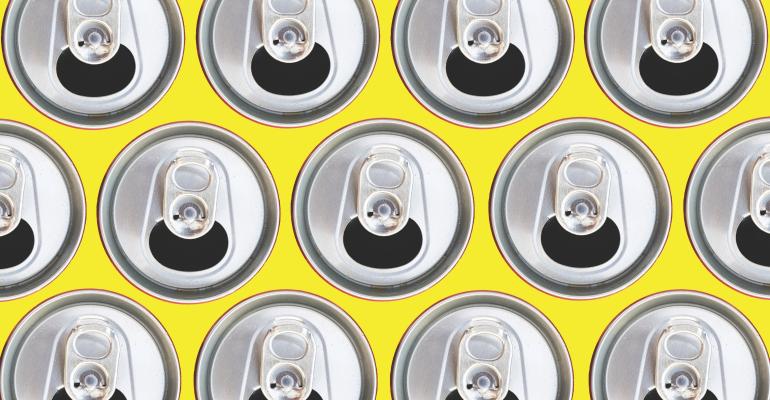The soft drinks sector is, quite literally, bursting with energy.
Rollouts of new energy drink products are on the rise as more merchandisers seek to leverage shoppers’ growing focus on options that meet their interest in convenience, health and
wellness, taste, and functionality.
“As consumers demanded more than just sustenance and refreshment from their food and beverage choices during the past couple of decades, a broad market of energy and performance-boosting products emerged,” according to Chicago-based market research firm Circana in its 2023 New Product Pacesetters report. “The slim can bursting with caffeine and flavor launched a market of high-intensity beverages and a revolution in carbonated and energy-boosting beverages began.”
That revolution is ongoing, particularly among the established brands that continue to launch new selections. Recent products include Cold & Crafted coffee from Starbucks for a “ready-to-drink boost,” the report noted. In addition, Gatorade rolled out Gatorlyte, which has a lower sugar content than its traditional sports drinks; and Red Bull began marketing Green Edition, which “provides energy and ‘vitalizes body and mind’ with its dose of dragon fruit.”
“Energy beverages are more nuanced than ever, as they are enhanced with benefits including vitamins and a hyperfocus on hydration,” New Product Pacesetters noted. “More than 41% of consumers say they want new beverages to help with hydration, better than 25% of consumers want more than basic nutritional benefits, and nearly 17% want an energy boost.”
More convenience-oriented consumers also are utilizing such drinks as protein shakes for snacking, said Sally Lyons Wyatt, Circana executive vice president and practice leader. She said that the growing variety of soft drink flavors and forms are making selections increasingly attractive to a wider range of consumer segments.
“There are certain drinks for persons trying to lose weight, those that need a boost from working out, or persons seeking to quench their thirst,” she said. “There are hundreds of flavors and manufacturers are getting very creative.”
Joining forces
Some suppliers, for instance, are co-branding energy drinks with popular candies, such as Skittles and Starburst. “They are going after consumers who appreciate the flavors of that candy brand and the equity that is in the brand,” Wyatt said, adding that some shoppers will not purchase a product without a familiar brand on the label.
“Co-branding is probably the hottest ticket in town,” she said. “For two years it has been one of the themes in innovation. Retailers like it because it adds excitement as they look for ways to get more foot traffic. People are looking for their favorite brand wherever it might be in the store.”
Having recognizable taste profiles is important, said Russell Zwanka, associate professor—food marketing, and director of the food marketing program at Western Michigan University in Kalamazoo. Flavor, along with functionality, are major factors driving consumer interest in soft drinks, he said.
“There is so much innovation in beverages, and soft drinks and energy drinks are leading the way,” Zwanka added.
Keeping pace with evolving consumer demands is also essential for sustaining and boosting soft drink sales, Zwanka said. “You must have a merchandising team that is completely focused on trends,” he said. “At any point, a new superfruit, super root, or functional flavor is being discovered and then virally explodes through TikTok, Instagram, or Snapchat.”
In addition, retailers must have a strong connection with all demographic and age groups to stay on trend with products, Zwanka said, while being willing to frequently adjust assortments. “Make quick decisions to accept and also quick decisions to remove the soft drinks and beverages that are not performing,” he said.
While offering newer products can result in a more vibrant soft drinks sector, merchandising challenges remain.
A soda merchandising conundrum
Soda sales at banners owned by B&R Stores Inc., a Lincoln, Neb.-based grocery company which operates 34 outlets in Nebraska, Iowa, and Missouri, have been steadily declining in conjunction with significant cost increases over the past three years, said Mark Griffin, the company’s president and chief operating officer. “Our promotional retail pricing on canned soda has doubled in four years,” he said.
B&R Stores, whose seven banners include Russ’s Market and Super Saver, is seeking to enhance soft drink revenues by such means as promoting multiple packages, including cans and plastic bottles, at the same price point, Griffin said. In addition, the retailer is bundling non-carbonated beverages, such as water, tea, and coffee, along with soft drinks at the same price to offer greater variety, draw more customers to the category, and enhance profitability, he said.
Because many consumers have not yet adjusted to higher soft drink costs, price remains the most significant sales obstacle, Griffin said. “Prices of very few, if any, items in our stores have increased at the same rate as soft drinks,” he said. “While we recognize elements in the supply chain cost more, we remain baffled by the rate of increases from major soft drink suppliers. We understand inflation but cannot draw a parallel to the increases.”
The retailer has raised prices to compensate for the “out of control” price enhancements from the beverage companies, he said. In addition, B&R Stores is responding to its greater expenses by promoting less frequently, reducing in-store displays, and relying on non-carbonated beverages to drive its beverage promotional strategy, Griffin said.
“Soft drinks were the core of the strategy as long as the company has existed—59 years,” he said. “However, we are now learning to drive our beverage business by deploying more innovative, creative, and analytical methods.”





